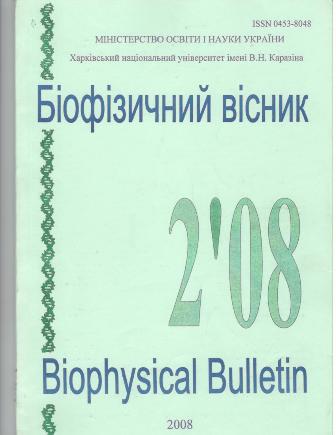Statistic model of muscle fibre contraction, caused by the exciton-soliton type collective excitations of α-spirals of myosin molecules
Abstract
The model, which shows that the skeletal muscle fiber contraction can be explained by the excitation of the α-spiral sections of the myosin molecules, is constructed. According to the model, the contraction occurs as a result of exciton-soliton type collective excitations, which are generated by ATF hydrolysis energy in the α-spiral sections of the myosin molecules. For calculating the force, which produces the separate excited myosin molecules, the methods of statistical physics were used. The force, generated by the entire sarcomere, is assumed to be the equal to the sum of the forces of the independent molecular motors. The dependence "force, generated by muscle - fiber length" for the single contraction, which is in a good agreement with experimental results, is obtained within the framework of a model. Model allows explaining the experimental facts, which do not find interpretation in the existing models of contraction.
Downloads
References
Structural Interpretation . // Nature. – 1954. – Vol. 173. – P. 973-976.
2. Piazzesi G., Reconditi M., Linari M., Lucii L., Sun Y.-B., Narayanan T., Boesecke P., Lombardi V., Irving
M. Mechanism of force generation by myosin heads in skeletal muscle. // Nature. – 2002. – Vol. 415(6872).
– P.659-62.
3. T.A.J. Duke. Molecular model of muscle contraction. // Proc. Natl. Acad. USA. – 1999. – Vol. 96. – P.
2770-2775.
4. Pollack G.H. Muscle and Molecules: Uncovering the Principles of Biological Motion. Seattle: Ebner and
Sons, 1990.
5. E. Brunello, P. Bianco, G. Piazzesi, M. Linari, M. Reconditi, P. Panine, T. Narayanan, W.I. Helsby, M.
Irving, V. Lombardi. Structural changes in the myosin filament and cross-bridges during active force
development in single intact frog muscle fibres: stiffness and X-ray diffraction measurements. // J. Physiol.
– 2006. – Vol. 577. – P. 971-984.
6. Pollack G.H. The cross-bridge theory. // Physiol. Reviews. – 1983. – Vol. 63. – P. 1049-1113.
7. Мирошниченко Н.С., Шуба М.Ф. Молекулярная организация сократительного аппарата и механика
мышечного сокращения. // Успехи физиол. наук. – 1990. – Т. 21, № 3. – С. 3-19.
8. Давыдов А.С., Супрун А.Д. Конфигурационные изменения и оптические свойства альфа-спиральных
белковых молекул // Украинский физический журнал. – 1974. – Т. 19, №1. - С. 44 – 50.
9. .Давыдов А.С. Биология и квантовая механика: Монографія. – К., Наукова думка, 1979. – 296 с.
10. Давыдов А.С. Солитоны в квазиодномерных молекулярных структурах // Успехи физических наук. –
1982. – Т. 138, вып. 4(12). – С. 603-643.
11. Фізика функціонування білків: Навч. посіб. / Супрун А.Д., Данилова В.М., Прилуцький Ю.І.,Шут А.М.
– К.: Шлях, 2004, – 90 с.
12. Бэгшоу К. Мышечное сокращение / Пер. с англ. Н. Габеловой. – М.: Мир, 1985. – 128 с.
13. A.D. Suprun, Yu.I. Prylutskyy, A.M. Shut, M.S. Miroshnichenko. Towards a dynamical model of skeletal
muscle // Український фізичний журнал. – 2003. - т. 48, № 7. – С. 704 – 707.
14. Супрун А.Д., Шут А.М., Прилуцький Ю.І. Моделювання рівняння Хілла для скорочення волокна
скелетного м'яза // Український фізичний журнал. – 2007. – Т. 52, №10. - С. 998 – 1001.
Authors who publish with this journal agree to the following terms:
- Authors retain copyright and grant the journal right of first publication with the work simultaneously licensed under a Creative Commons Attribution License that allows others to share the work with an acknowledgement of the work's authorship and initial publication in this journal.
- Authors are able to enter into separate, additional contractual arrangements for the non-exclusive distribution of the journal's published version of the work (e.g., post it to an institutional repository or publish it in a book), with an acknowledgement of its initial publication in this journal.
- Authors are permitted and encouraged to post their work online (e.g., in institutional repositories or on their website) prior to and during the submission process, as it can lead to productive exchanges, as well as earlier and greater citation of published work (See The Effect of Open Access).





